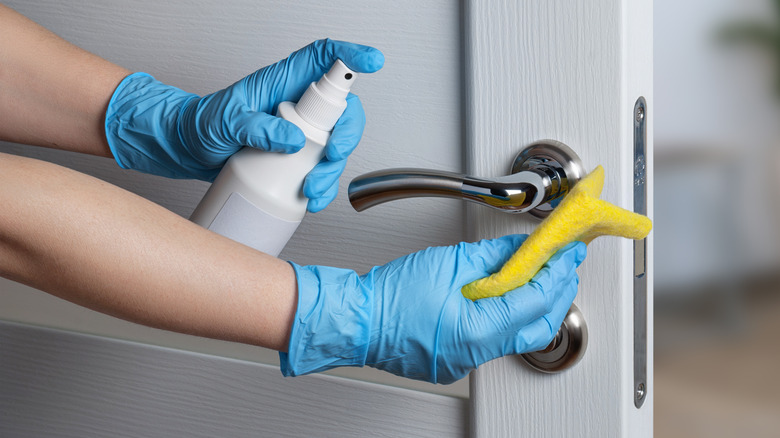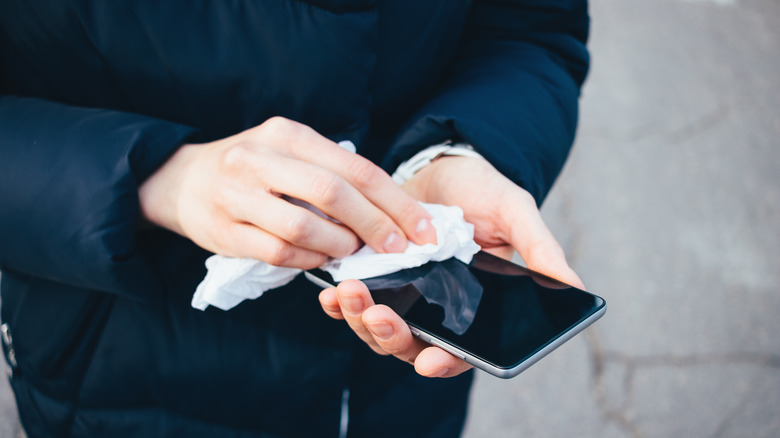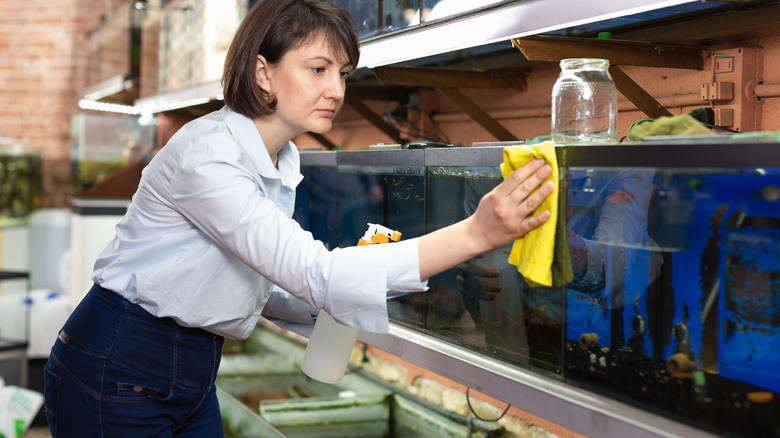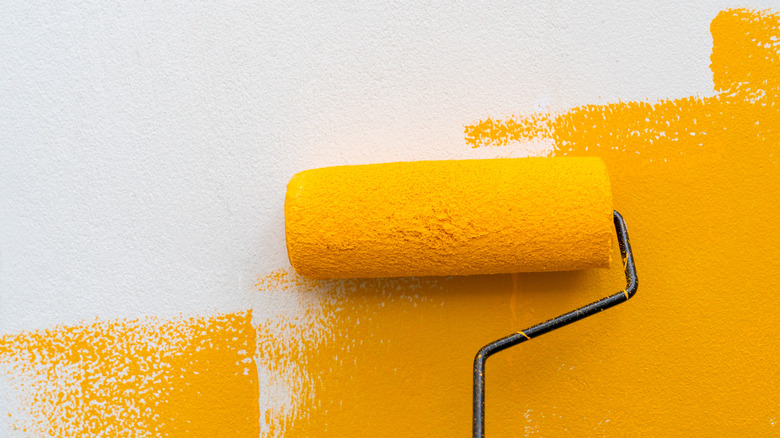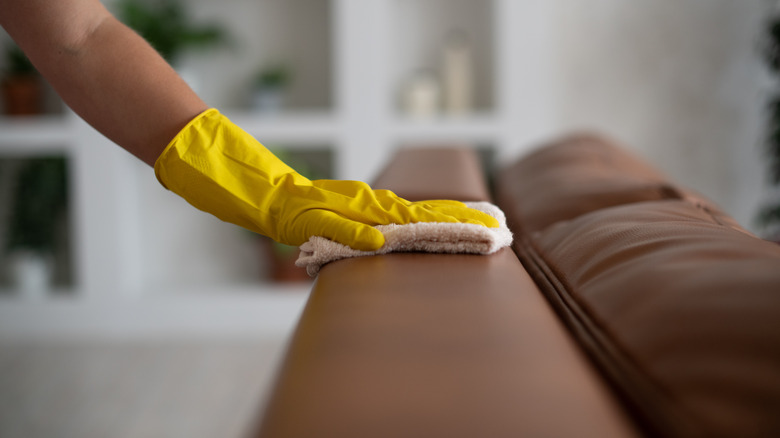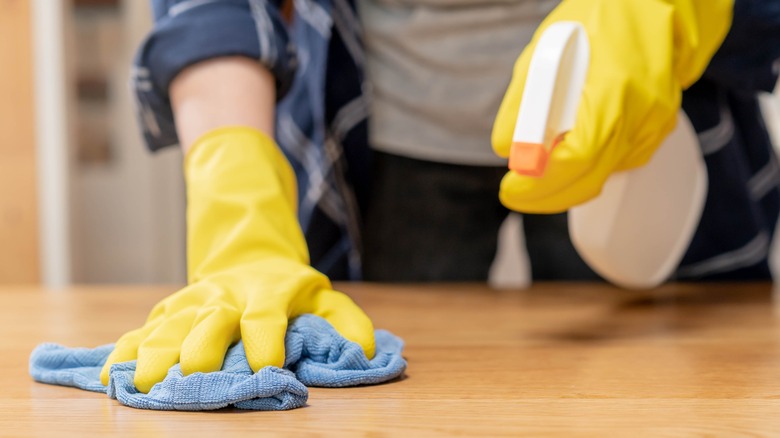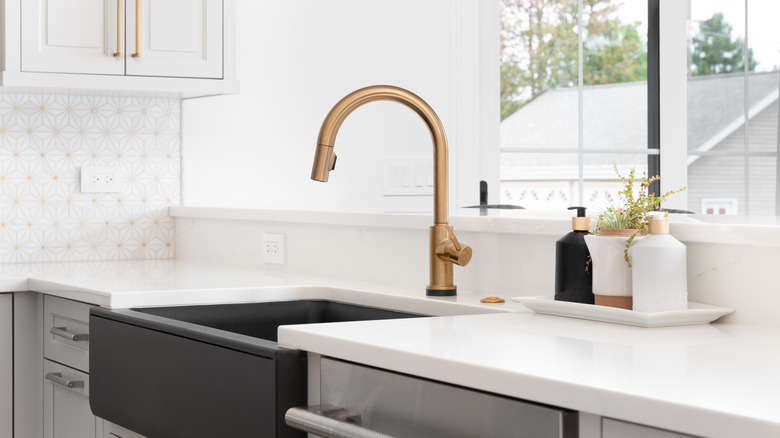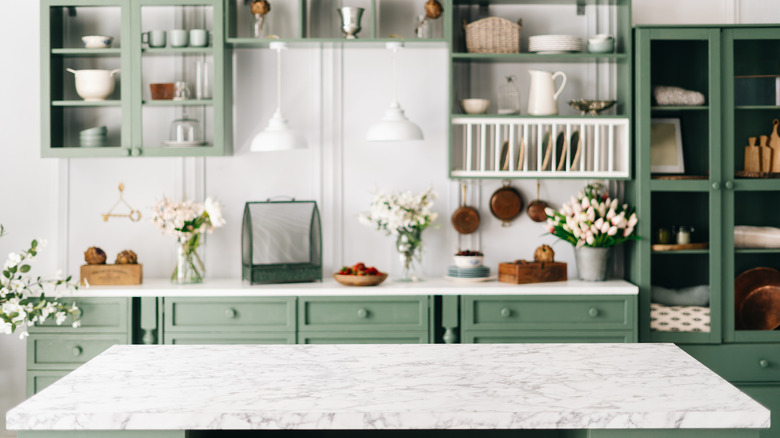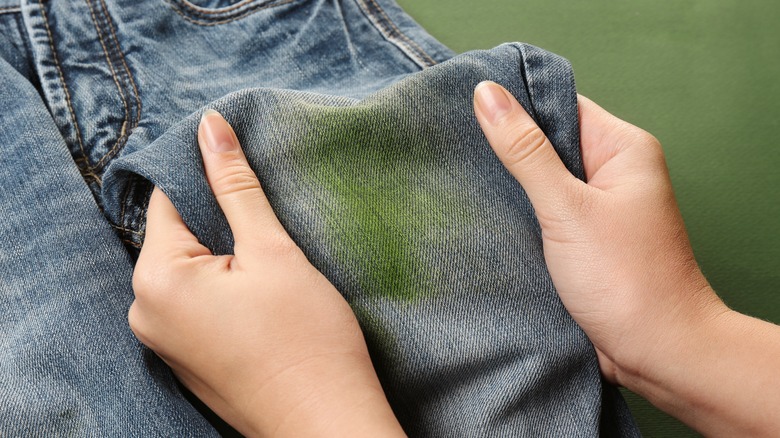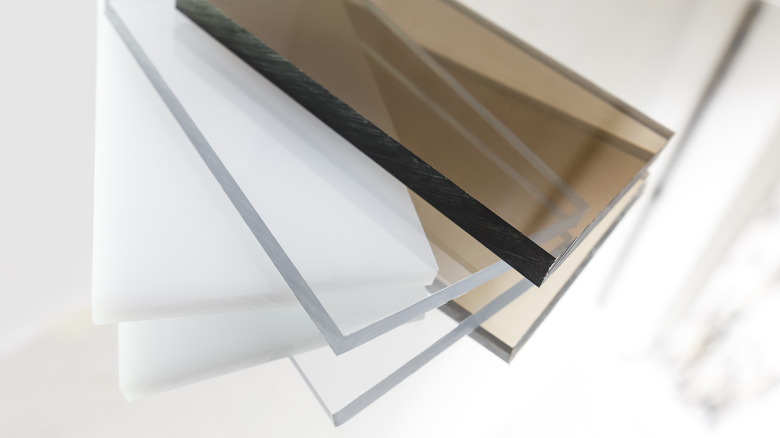Common Things You Should Never Clean With Rubbing Alcohol
Rubbing alcohol is a powerful cleaning product many people swear by for tackling tough stains and grime. Also known as isopropyl alcohol, it is a colorless liquid that is made by combining water and propylene or ethylene. One benefit of using rubbing alcohol as a cleaning agent is that it is a potent disinfectant that can kill bacteria and viruses. In addition, it evaporates quickly, leaving behind no residue, making it convenient and efficient. According to WebMD, rubbing alcohol is also ideal for getting rid of plant pests, removing stains like ink, treating ear infections, and creating DIY hand sanitizer.
While rubbing alcohol can be an effective cleaning product in many situations, there are specific things you shouldn't clean with it. Using rubbing alcohol on certain surfaces or materials can cause damage or discoloration, so it's important to be aware of what to avoid. From electronics and some plastics to colored fabrics and granite, there are several common items that you should steer clear of cleaning with rubbing alcohol. We're going to dive into the details of what not to clean with rubbing alcohol and why. By understanding the limitations of this powerful cleaning agent, you can avoid costly mistakes and keep your belongings in top condition.
Don't use it on electronics
Rubbing alcohol is a great disinfectant, but when it comes to cleaning electronics, it's best to avoid using it. This is because rubbing alcohol can strip away the protective coating on screens, keyboards, and other devices, making them vulnerable to scratches, discoloration, and other damage. Additionally, rubbing alcohol can cause plastic and rubber parts to dry out and become brittle, which can lead to cracking or breaking. Moreover, rubbing alcohol is often mixed with water, which is never good for getting on electronics. Repeated use of rubbing alcohol on electronics can cause them to deteriorate, shorten their lifespan, and ultimately cost you more in repairs or replacements.
Fortunately, there are alternative ways to safely clean electronics. For instance, a microfiber cloth is gentle and won't scratch delicate surfaces. Compressed air can also be used to blow dust and debris away from keyboards and other crevices. Additionally, there are specialized cleaning solutions formulated for electronics, such as a screen cleaner or keyboard cleaner. These products are designed to be safe for electronics and not cause any damage. A good rule of thumb when cleaning electronics is to always turn them off or unplug them before cleaning. By using these alternative cleaning methods, you can keep your electronics clean and well-maintained without risking any damage.
Avoid cleaning acrylics
Rubbing alcohol is a versatile cleaning agent, but it's not the best choice when it comes to cleaning acrylics. Acrylics are a type of plastic that is commonly used in a variety of applications, including in aquariums, picture frames, and other decorative items. When acrylics come into contact with rubbing alcohol, it can cause them to become cloudy or discolored, which detracts from their appearance. Rubbing alcohol can weaken the structural integrity of acrylics over time, which causes them to crack or break. If you want to keep your acrylics looking their best, avoid using rubbing alcohol to clean them.
Instead, there are alternative cleaning methods that are safe for acrylics. One option is to use a soft, lint-free cloth and a mild soap to clean the surface of the acrylic. Be sure to avoid using any abrasive cleaners or scrubbers, as these can easily scratch the surface. Another option is to use a specialized acrylic cleaner, which is designed to be gentle and won't cause additional damage to it. Two Way Mirrors also recommends using disposable wipes since they dry quickly and won't leave any dirt or residue behind. The products you use when cleaning acrylics should be soft, dirt-free, and gentle enough to keep scratches from forming.
Keep it off of painted surfaces
Using rubbing alcohol to clean painted surfaces can do more harm than good. Rubbing alcohol can dissolve and strip away paint, leaving behind unsightly discoloration and damage. Additionally, rubbing alcohol also causes the painted surface to become brittle and crack over time, which can be costly to repair. Where rubbing alcohol is helpful when it comes to painting is using it to clean walls before you layer them with paint. According to Paints Geek, rubbing alcohol helps remove dirt from the wall, which will allow for a smooth coat to be applied. It also removes oils and other small contaminants that might otherwise make the coat look uneven.
If you're looking to clean a painted surface, there are better cleaning solutions that are safer than rubbing alcohol. The first method is using a mild soap and a soft cloth to gently clean the surface of the paint. Be sure to rinse the surface thoroughly with water and dry it with a clean microfiber cloth to avoid water spots. For tougher stains, you can try using a specialized cleaner such as a paint-safe degreaser. These products are safe for painted surfaces and won't cause any unnecessary damage or long-term discoloration.
Don't clean leather with it
Leather is a delicate material that harsh chemicals can easily damage, and rubbing alcohol is one of them. When exposed to this powerful cleaning agent, leather can become discolored, dried out, and cracked. This can lead to you having to repair or replace the item. Repeated use of rubbing alcohol on leather causes the material to deteriorate over time, making it more prone to long-term damage. This is because use rubbing alcohol can prematurely age the leather, which means it won't last as long as originally intended.
To clean leather properly, focus first on using a specialized leather cleaner, which is designed to be gentle on the material. Often, furniture stores will sell these products, though you can shop for different brands online. Another option is to use a mild soap solution and a soft cloth to clean the surface of the leather. Avoid using any harsh scrubbers or brushes, as these can damage the surface and create prolonged problems, like tearing. After cleaning, be sure to condition with a leather conditioner to keep it soft and supple.
It's not safe on wood
Rubbing alcohol may be a great all-purpose disinfectant, but it's not a good choice for cleaning wood. Using rubbing alcohol on wood can cause the finish to become stripped, leaving the wood exposed and vulnerable to additional problems. Over time, this causes the wood to become discolored and faded, and it can even cause warping or cracking. According to Hunker, rubbing alcohol doesn't stain wood. Rather, it liquefies the finish, which leads to splinters and more surface-level damage. That's why it's best to avoid rubbing alcohol on wood of any kind.
Luckily, you have plenty of alternative cleaning solutions that are safe for wood furniture and surfaces. You can use a little bit of soap and a microfiber cloth, just be sure to rinse the surface thoroughly with water and dry it with a clean, soft cloth to keep water spots from forming. There are also wood cleaners that aim to keep the surface smooth and long-lasting. For tough stains or buildup, you can try using a wood-safe degreaser or a natural cleaner like vinegar or lemon juice. These alternative cleaning methods will keep your wood surfaces looking clean and well-maintained without risking any permanent damage.
Keep it away from granite
Rubbing alcohol may seem like a good choice for cleaning granite surfaces, but it can actually be detrimental. Granite is a porous stone, which means that it can absorb liquids like rubbing alcohol, causing it to become discolored and damaged over time. In addition, rubbing alcohol breaks down the sealant on granite surfaces, which can lead to stains and other risks. While you can use rubbing alcohol to disinfect the surface, it should be used sparingly. Mix equal parts water with 91% rubbing alcohol in a spray bottle and use it when deep cleaning only.
For regular cleaning, it's best to use specially-made granite cleaners. As with most other solutions, mild soap mixed with water is still one of the best cleaning methods. Avoid harsh scrubbers or abrasive materials since these can scratch the granite and it can cost a lot to repair. For tougher stains, you can use baking soda mixed with water or a touch of hydrogen peroxide. This creates a thick paste that will work deep into the stain and can then be easily wiped away with warm water and a gentle cloth.
The same goes for marble
Like granite, marble is a porous stone, and harsh chemicals can easily damage it. When exposed to rubbing alcohol, marble can become discolored, etched, or even cracked, which can be unsightly and costly to repair. One long-term effect rubbing alcohol can have on marble is that it can break down the natural protective layer that exists on the surface if used too often. This makes it more vulnerable to scratches and staining. Instead, try these alternative cleaning solutions that are safe for marble.
The basic and most common way to clean marble is with simple soap and water. You want to avoid using any acidic or abrasive cleaners, though, as these cause damage to the surface. You can also use specialized marble cleaners, but Academy Marble states that any cleaner with natural pH levels will do a fine job of keeping your marble clean. Other options include making a baking soda paste for deeper stains or hydrogen peroxide for spot stains. These solutions are easy to clean and help keep your marble surface thoroughly disinfected.
Avoid using it on colored fabrics
Rubbing alcohol should never be used on colored fabrics. This is because rubbing alcohol can cause the colors to fade or bleed, leaving you with a stained or discolored garment. It also weakens the fibers, making them more susceptible to damage and wear. If you accidentally spill rubbing alcohol on a colored fabric, act quickly to remove the stain by blotting the area with a clean cloth. You can then treat the stain with a specialized cleaner or simply use a mixture of vinegar and water to soak the spot. While you can use rubbing alcohol to spot clean fabrics like cotton, nylon, and polyester, it's best to overall use alternative cleaning methods to avoid any unnecessary damage.
For starters, you can use cleaners that are gentle on fabrics like Tide Pens. These won't cause any discoloration or damage on colored fabrics and are great to use when out and about. Another option is to use a mild detergent and cold water. You want to make sure you test a small, inconspicuous area of the fabric first to ensure that it is colorfast and won't be damaged by the cleaning solution. These methods help to minimize the risk caused by rubbing alcohol and keep your colored fabrics looking vibrant.
Keep it away from certain plastics
While rubbing alcohol is a powerful cleaning agent, it should not be used to clean certain types of plastics, such as polycarbonate, acetate, and vinyl. These plastics are particularly sensitive to rubbing alcohol, which can cause them to crack, discolor, or become brittle over time. One alternative cleaning solution for these types of plastics, according to Castle Keepers, is to use a combination of mild soap and water. To remove any soap residue, rinse the surface thoroughly with clean water but avoid using paper towels as these can scratch the plastic.
Another cleaning alternative is to use a plastic cleaner that is designed to be gentle on these types of surfaces. These cleaners are formulated to remove dirt, grime, and stains without leaving behind streaks or scratches. It's also important to take preventative measures to protect your plastic surfaces from damage. Avoid exposing them to direct sunlight or extreme temperatures, as these are quick to cause them to crack. And, if possible, store your plastic items in a cool, dry place when not in use to help extend their lifespan.
